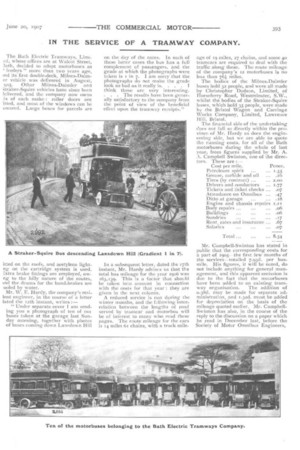IN THE SERVICE OF A TRAMWAY COMPANY.
Page 17

Page 18

If you've noticed an error in this article please click here to report it so we can fix it.
The Bath Electric Tramways, Limt. ed, whose offices are at Walcot Street, 3ath, decided to adopt motorbuses as feeders " more than two years ago, ,nd its first double-deck, Milnes-Daimer vehicle was delivered in August, god. Other Milnes-Daimler and ;traker-Squire vehicles have since been lelivered, and the company now owns ix of each make : roller doors are itted, and most of the windows can be owered. Large boxes for parcels are itted on the roofs, and acetylene lightng on the cartridge system is used. 2:xtra brake fittings are employed, ow. ng to the hilly nature of the routes, Ind the drums for the band-brakes are poled by water.
Mr. W. E. Hardy, the company's resilent engineer, in the course of a letter lated the 12th instant, writes :
" under separate cover I am sending you a photograph of ten of oui buses taken at the garage last Sunday morning, together with photos of buses coming down Lansdown Hill
on the day of the rates. In each of these latter cases the bus has a full complement of passengers, and the grade at which the photographs were taken is i in 7. I am sorry that the photographs do not make the grade look so bad as it really is. . . . think these are very interesting.
. The results have been generally satisfactory to the company from the point of view of the beneficial effect upon the tramway receipts."
In a subsequent letter, dated the 17th instant, Mr. Hardy adyiscs us that the total ims mileage for the year 1906 was 163,139. This is a factor that should be taken into account in connection with the costs for that year : they are given in the next column.
A reduced service is run during the winter months, and the fcllowing interrelation between the lengths of road served by tramcar and motorbus will be of interest to many who read these pages. The route mileage for the cars is 14 miles 61 chains, with a track mile age of 19 miles, 27 chains, and some 40 tramcars are required to deal with the traffic along these. The route mileage of the company's 12 motorbuses is no less than 76k miles.
The bodies of the Milnes-Daimler buses hold 32 people, and were all made by Christopher Dodson, Limited, of Horseferry Road, Westminster, SW., whilst the bodies of the Straker-Squire buses, which hold 35 people, were made by the Bristol Wagon and Carriage Works Company, Limited, Lawrence Hill, Bristol.
The financial side of the undertaking does not fall so directly within the province of Mr. Hardy as does the engineering side, but we are able to quote the running costs, for all of the Bath motorbuses during the whole of last Year, from figures supplied by Mr. A, A. Campbell Swinton, one of the directors. These are :— Cost per mile. Pence.
Petroleum spirit ... ••• 1-55
Grease, carbide and oil ... .26
Tires (by contract) ... ... 2.00
Drivers and conductors ... 2.77 Tickets and ticket checks ... .o7
Attendance on Omnibus ... .47
Ditto at garage ... ... .28
Engine and chassis repairs 1.21 Body repairs ... .o6
Buildings . . .06 Sundries Rent, rates and insurance ... .67 Salaries Total ... ... 8.54 -
Mr. Campbell-Swinton has stated in public that the corresponding costs for a part of igosthe first few months of the services—totalled 7.93d. per busmile. His figures, it will be noted, do not include anything for general management, and this apparent omission is due to the fact that the motorbuses have been added to an existing tram way organisation. The addition of o.38d. may be made for separate administration, and I.3od. must be added for depreciation on the basis of the mileage quoted earlier. Mr. CampbellSwinton has also, in the course of the reply to the discussion on a paper which he read in December last, before the Society of Motor Omnibus Engineers,
stated that his co-directors do not expect the motorbuses of themselves to make any very large amount of profit, provided they can continue to run them without loss, as they made an extra profit out of the tramways, and they were satisfied that the omnibuses did run very economically.
It should not be overlooked that the traffic to and from Bath particularly on some of the longer routes, one of which exceeds 20 miles, is not of what is known as a " pick-up " character, although the buses will stop whenever they are hailed by anybody at the roadside. This absence of frequent stoppages and re-startings naturally tends Lo economy of fuel consumption, and lessens the cost of repairs. The general manager of the company, Mr. R.
D. McCarter, has also borne testimony to the behaviour of the machines, and to the encouraging nature of the results from the traffic standpoint, in the course of his contribution to the discussion on Mr. Manville's classic paper at the Royal Automobile Club, to which paper we made a brief reference in our introductory section, The departdre has been entirely advantageous,






























